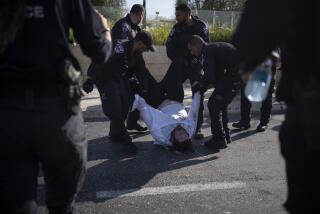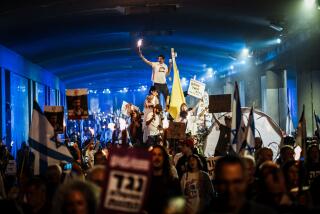Histadrut Elections Likely to Shape Israel’s Political Future
- Share via
JERUSALEM — If there were an American counterpart for Israel’s Histadrut--and there isn’t--it would be a conglomerate encompassing the AFL-CIO, General Motors, Security Pacific Bank, Sears, Roebuck and Medicare.
Even such a combination wouldn’t touch the life of the average American the way the Histadrut, or General Federation of Labor, pervades life in Israel.
As a trade union, its membership covers about 80% of the Israeli labor force. Its enterprises account for about a quarter of Israel’s gross national product and two-thirds of its food. They include the nation’s largest industrial conglomerate, its second-largest bank and its largest construction firm.
Its cooperative bus companies are the primary means of transportation for most Israelis, who do much of their shopping in Histadrut-owned department stores and supermarkets. It publishes a major newspaper and delivers milk.
Three of four Israelis depend on a national system of clinics and hospitals administered by Histadrut for health care.
“I don’t think anybody in this country can go a day without having contact with a Histadrut enterprise,” Daniel Elazar, director of the Jerusalem Center for Public Affairs, said recently.
Because Histadrut reaches into almost every corner of Israeli life, it is no wonder that elections to fill its top offices, scheduled for today, are seen as a major political test, second in importance only to elections for the Knesset, Israel’s parliament.
The head of Histadrut has always been a member of parliament--the incumbent, Yisrael Kessar, is no exception--and within Israel is probably as well known as the prime minister.
Names of the candidates for 1,501 Histadrut offices being contested appear on election lists representing the same political parties that compete for seats in the Knesset. Proportionately, the number of voters expected to take part rivals the usual turnout for a presidential election in the United States. Monday’s election is seen as an important national referendum for the two principal political groups in Israel’s coalition government--the Labor alignment, headed by Prime Minister Shimon Peres, and the Likud bloc, headed by Yitzhak Shamir, the foreign minister and alternate prime minister.
For if the Labor alignment makes a particularly strong showing, it will encourage those within the party who want to break up the coalition in the hope that new parliamentary elections will give Labor enough of an edge to form a government in which it would not have to share power with Likud.
In addition, control of Histadrut gives a party access to political tools such as money and patronage.
Historically, Histadrut has been dominated by the Labor alignment and its predecessors. Labor won 63% of the last Histadrut vote in 1981, compared to less than 27% for the conservative and nationalistic Likud bloc. The rest of the vote was divided among smaller parties.
Still, Likud has improved its showing in Histadrut elections and if it can get 33% of the vote it will qualify, for the first time, for representation on the federation’s governing bodies. Likud would like nothing better than to neutralize the Histadrut as an arm of the Labor alignment.
Formed in 1920, Histadrut was rooted in the ideals of Labor Zionism--the movement dedicated to building a Jewish homeland in what was then Palestine.
While most of the world’s labor movements evolved in response to the exploitation of working people, the most pressing need for the 80,000 Jews in Palestine in 1920 was finding work. So the Histadrut set out not so much to protect workers as to build a Jewish economy in a land administered by the British and where the majority of people were Arabs. “The Histadrut was, in fact, the first element of statehood,” said Yitzhak Ben Aharon, a retired member of the Knesset who headed Histadrut for five years.
Its first general secretary was Israel’s founding father, David Ben Gurion, who headed the federation for 15 years before becoming Israel’s first prime minister.
The Hagannah, the forerunner of Israel’s army and the backbone of the Jewish fighting force in the War of Independence, began as an extension of the workers’ defense units of Histadrut. Kupat Holim, the Workers’ Sick Fund, built its first clinic to treat pioneers who fell ill with malaria while draining the swamps of the Jezreel Valley. Today it provides medical care to 75% of the Israeli population and is financed out of Histadrut dues. Bank Hapoalim was founded the year after Histadrut as the labor movement’s financial institution.
43 Trade Unions
Critics contend that although Histadrut was a vital force in the creation of the state, it has become a major contributing factor in Israel’s economic crisis.
It brings together 43 different trade unions covering groups as divergent as actors and airline pilots, lifeguards and physiotherapists. With 1.5 million members, it can paralyze the country.
In the past 10 years, Histadrut strikes have cost the economy, on average, more than 600,000 workdays a year. During the Likud years in power, after 1977, the figure rose to 900,000 days a year. Too often, critics say, Histadrut’s power is used to shield incompetent workers and otherwise encourage economic inefficiency.
Steps Put Off
A Histadrut-inspired indexing system for wages, pensions and other financial arrangements has protected workers from the worst ravages of inflation, which peaked last fall at an annual rate of more than 1,000%. But many economists say the system has perpetuated the inflationary spiral and that it must be changed if the country is to bring its economy under control.
Fearful of the possible impact on today’s elections, Israeli officials have put off tough economic steps until after the balloting. Thus the elections are expected to signal the beginning of another phase in the campaign for economic recovery.
More to Read
Sign up for Essential California
The most important California stories and recommendations in your inbox every morning.
You may occasionally receive promotional content from the Los Angeles Times.













